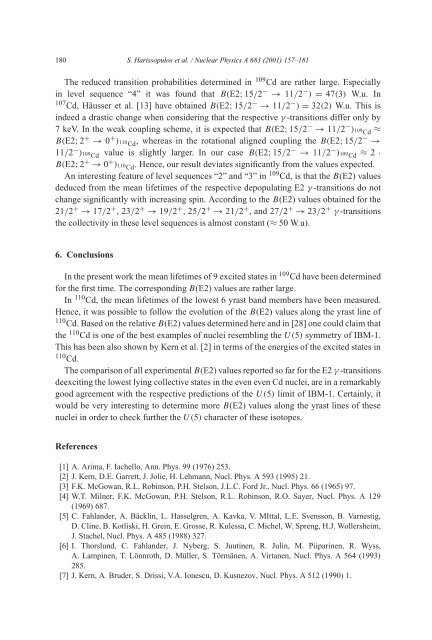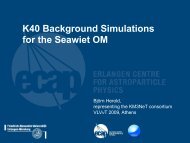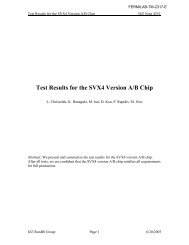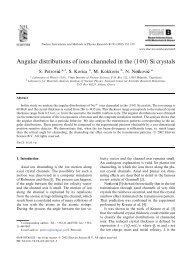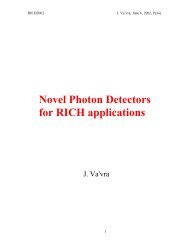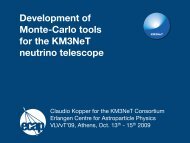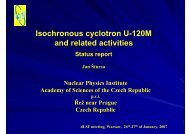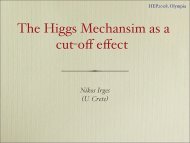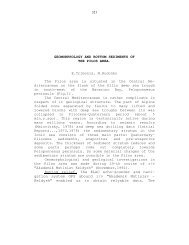Picosecond lifetime measurements in 109Cd and 110Cd
Picosecond lifetime measurements in 109Cd and 110Cd
Picosecond lifetime measurements in 109Cd and 110Cd
You also want an ePaper? Increase the reach of your titles
YUMPU automatically turns print PDFs into web optimized ePapers that Google loves.
180 S. Harissopulos et al. / Nuclear Physics A 683 (2001) 157–181<br />
The reduced transition probabilities determ<strong>in</strong>ed <strong>in</strong> 109 Cd are rather large. Especially<br />
<strong>in</strong> level sequence “4” it was found that B(E2; 15/2 − → 11/2 − ) = 47(3) W.u. In<br />
107 Cd, Häusser et al. [13] have obta<strong>in</strong>ed B(E2; 15/2 − → 11/2 − ) = 32(2) W.u. This is<br />
<strong>in</strong>deed a drastic change when consider<strong>in</strong>g that the respective γ -transitions differ only by<br />
7 keV. In the weak coupl<strong>in</strong>g scheme, it is expected that B(E2; 15/2 − → 11/2 − )109 Cd ≈<br />
B(E2; 2 + → 0 + )110 Cd , whereas <strong>in</strong> the rotational aligned coupl<strong>in</strong>g the B(E2; 15/2− →<br />
11/2 − )109 Cd value is slightly larger. In our case B(E2; 15/2− → 11/2 − )109 Cd ≈ 2 ·<br />
B(E2; 2 + → 0 + )110 Cd . Hence, our result deviates significantly from the values expected.<br />
An <strong>in</strong>terest<strong>in</strong>g feature of level sequences “2” <strong>and</strong> “3” <strong>in</strong> 109 Cd, is that the B(E2) values<br />
deduced from the mean <strong>lifetime</strong>s of the respective depopulat<strong>in</strong>g E2 γ -transitions do not<br />
change significantly with <strong>in</strong>creas<strong>in</strong>g sp<strong>in</strong>. Accord<strong>in</strong>g to the B(E2) values obta<strong>in</strong>ed for the<br />
21/2 + → 17/2 + ,23/2 + → 19/2 + ,25/2 + → 21/2 + , <strong>and</strong> 27/2 + → 23/2 + γ -transitions<br />
the collectivity <strong>in</strong> these level sequences is almost constant (≈ 50 W.u).<br />
6. Conclusions<br />
In the present work the mean <strong>lifetime</strong>s of 9 excited states <strong>in</strong> 109 Cd have been determ<strong>in</strong>ed<br />
for the first time. The correspond<strong>in</strong>g B(E2) values are rather large.<br />
In 110 Cd, the mean <strong>lifetime</strong>s of the lowest 6 yrast b<strong>and</strong> members have been measured.<br />
Hence, it was possible to follow the evolution of the B(E2) values along the yrast l<strong>in</strong>e of<br />
110 Cd. Based on the relative B(E2) values determ<strong>in</strong>ed here <strong>and</strong> <strong>in</strong> [28] one could claim that<br />
the 110 Cd is one of the best examples of nuclei resembl<strong>in</strong>g the U(5) symmetry of IBM-1.<br />
This has been also shown by Kern et al. [2] <strong>in</strong> terms of the energies of the excited states <strong>in</strong><br />
110 Cd.<br />
The comparison of all experimental B(E2) values reported so far for the E2 γ -transitions<br />
deexcit<strong>in</strong>g the lowest ly<strong>in</strong>g collective states <strong>in</strong> the even even Cd nuclei, are <strong>in</strong> a remarkably<br />
good agreement with the respective predictions of the U(5) limit of IBM-1. Certa<strong>in</strong>ly, it<br />
would be very <strong>in</strong>terest<strong>in</strong>g to determ<strong>in</strong>e more B(E2) values along the yrast l<strong>in</strong>es of these<br />
nuclei <strong>in</strong> order to check further the U(5) character of these isotopes.<br />
References<br />
[1] A. Arima, F. Iachello, Ann. Phys. 99 (1976) 253.<br />
[2] J. Kern, D.E. Garrett, J. Jolie, H. Lehmann, Nucl. Phys. A 593 (1995) 21.<br />
[3] F.K. McGowan, R.L. Rob<strong>in</strong>son, P.H. Stelson, J.L.C. Ford Jr., Nucl. Phys. 66 (1965) 97.<br />
[4] W.T. Milner, F.K. McGowan, P.H. Stelson, R.L. Rob<strong>in</strong>son, R.O. Sayer, Nucl. Phys. A 129<br />
(1969) 687.<br />
[5] C. Fahl<strong>and</strong>er, A. Bäckl<strong>in</strong>, L. Hasselgren, A. Kavka, V. MIttal, L.E. Svensson, B. Varnestig,<br />
D. Cl<strong>in</strong>e, B. Kotliski, H. Gre<strong>in</strong>, E. Grosse, R. Kulessa, C. Michel, W. Spreng, H.J. Wollersheim,<br />
J. Stachel, Nucl. Phys. A 485 (1988) 327.<br />
[6] I. Thorslund, C. Fahl<strong>and</strong>er, J. Nyberg, S. Juut<strong>in</strong>en, R. Jul<strong>in</strong>, M. Piipar<strong>in</strong>en, R. Wyss,<br />
A. Lamp<strong>in</strong>en, T. Lönnroth, D. Müller, S. Törmänen, A. Virtanen, Nucl. Phys. A 564 (1993)<br />
285.<br />
[7] J. Kern, A. Bruder, S. Drissi, V.A. Ionescu, D. Kusnezov, Nucl. Phys. A 512 (1990) 1.


